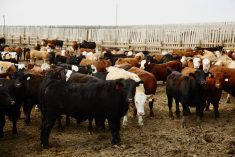I’ve had many inquiries over the past month in regards to the feed grains outlook. Barley prices in southern Alberta have been percolating higher throughout the fall period reaching $190/mt in late December. Adverse temperatures and wintry-type conditions have slowed farmer selling and it appears that the fundamental structure will be tighter than earlier anticipated. Many feedlot operators were anticipating lower barley prices due to abundant feed wheat supplies but stronger export values have limited the stocks coming on the domestic market. I think it is very important that feedlot operators have a clear understanding of the market dynamics and what the supply and demand forces need to accomplish over the next eight months. In this issue, I’m going back to the basics of “Market Analysis 101” so that there is no confusion.
Read Also

Cattle Market Summary
Break-evens, cow and calf prices, plus market summaries courtesy of Canfax and Beef Farmers of Ontario. Cost of Production May…
Over the past five years barley prices in southern Alberta have fluctuated in a $100 range from the lows of $150/mt to highs of $250/mt. The old historical lows were at $100/mt but we use the five-year historical period as this is when ethanol started consuming a larger portion of the U.S. corn crop putting feed grain historical prices in a new range. When the market is trading in the range of $150/mt to $180/mt, the market discourages production and encourages consumption. When the southern Alberta barley market is trading in the range of $220/mt to $250/mt, the market encourages production but discourages consumption. We can generally say that supply and demand are in equilibrium when the market is trading in the range of $180/mt to $220/mt.
Statistics Canada’s estimated barley production at 7.605 millionmt isoneofthesmallestcropsinhistory. Itappears that total Canadian barley exports could reach 2.35 million mt which leaves the remainder for domestic usage and carry-out. Notice that the feed consumption is estimated at 5.6 million mt, approximately 3.2 million mt below the 10-year average and the carry-out is under one million mt, also sharply below the historical average. The market needs to encourage production in 2011 but in the short term, the barley market will ration demand. This requires southern Alberta values to trade at a sharp premium to export values but also needs to encourage imports of DDGS from the U.S. Therefore, I believe that barley will trade at historical highs later in spring or early summer because stocks are going to be extremely tight.
The same analytical procedure can be used on the corn market. We can say that the historical price range for CBOT corn is from lows of $3/bu. to highs of $7.50. The lower-third price range is from $3 to $4.50, the middle range of balance is between $4.50 and $6 and the upper range is from $6 to $7.50. The U.S. corn carry-out is projected to drop under 900 million bushels which is historically tight. However, world corn ending stocks are also below the five-year average as per my chart above. This is important because the market is now in a situation where any crop problem in South America could cause prices to rally up to the upper-third price range. Next spring, if it looks like U.S. acres will be under 93 million, this could also spur on further strength.
In conclusion, the barley market needs to ration demand and encourage acres next spring. This will result in historically high prices in the Canadian domestic market. Producers are encouraged to be more aggressive with forward purchases. Corn prices are also in a situation where any crop problems could cause the market to move into the upper third of the historical price range.
GeraldKlassenanalysesmarketsinWinnipegandalsomaintainsaninterestinthefamilyfeedlotinsouthernAlberta.Hecanbereachedat [email protected] or204-287-8268.














